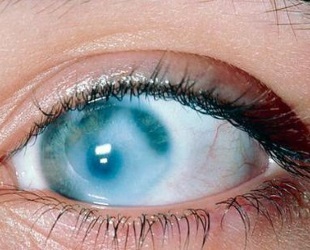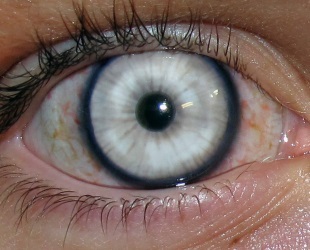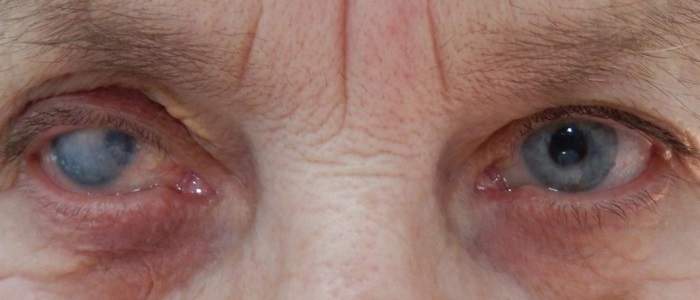
The opacity of the eye's cornea in the people is often called a thorn. This is a dangerous pathology, which in the absence of adequate treatment can lead to a complete loss of vision.
The causes of turbidity can be different factors, ranging from diseases of the organs of vision and ending with mechanical injuries.
When diagnosed at an early stage, this phenomenon is cured without consequences, and compliance with prevention measures can completely avoid it and preserve eye health for a long time.
In order to detect the disease in time, it is important for each of us to know the risk factors and symptoms of corneal opacity.
- 1. What is it?
- 2. Causes of corneal opacity
- 3. Symptoms and Diagnosis
- 4. Treatment of corneal opacity
- 5. Prognosis for
- 6. Prevention of corneal opacity
- 7. Conclusion
What is it?
The history of

The Belmo is one of the oldest diseases of the eye, which was mentioned in the works of Avicenna and medieval physicians.
This phenomenon is cicatricial changes in the retina of the eye responsible for central vision.
For this reason, a person begins to see badly even those objects that are directly in front of him, and with time the disease progresses.
The prevalence of
According to statistics, about 285 million people worldwide suffer from eye pathologies from , and corneal opacity is one of the leading causes among such ailments.
With the advent of laser surgery and other innovative methods of fighting with ophthalmic diseases, cases of blindness due to the development of the belly have significantly decreased.
Who is affected?
Most often, corneal opacity develops due to age-related changes in the body, but there are a number of causes and factors that can cause pathology in young people.
Causes of corneal opacity
The causes of the disease include infectious or inflammatory eye diseases, mechanical trauma and impaired vision hygiene:
- keratitis( inflammation of the cornea of the eye);
- complications after a number of diseases, including measles, syphilis, tuberculosis;
- herpes virus that has fallen on the cornea;
- conjunctivitis and other ophthalmic infections;
- mechanical or chemical injury to organs of sight, foreign objects;
- surgical eye surgery.
Risk factors that can provoke corneal opacification include a lack of vitamin A and misuse of contact lenses. With improper care or too long wearing under lenses, pathogenic microorganisms develop that cause diseases of the eye.
Symptoms and Diagnosis
The opacity of the cornea can usually be seen with the naked eye: on the surface appear areas of grayish color, which are called clouds, spots and thorns. Clouds resemble small smoke, located in the center of the protein.
Spots are more pronounced, and thorns are persistent and obvious opacities that occupy the vast part of the cornea. Similar manifestations are accompanied by the following symptoms:
- redness of proteins;
- photophobia;
- partial or total loss of vision;
- tear;
- discomfort or sensation of a foreign object in the eye.
If you develop one or more symptoms, you should immediately consult a doctor, as modern diagnostic methods can detect the disease in the early stages.
The diagnosis begins with the collection of anamnesis, visual examination of the eyes and checking the visual acuity of the patient. When suspected of corneal opacity, a special device called Amsler's lattice is used.

The patient focuses on the point indicated by the ophthalmologist, and if the nearby lines appear to him wavy rather than straight, this indicates degenerative changes in the eye.
To clarify the diagnosis, patients undergo ultrasound of the organs of vision and biomicroscopy: the first procedure is aimed at studying the whole eye, and the second is aimed at the anterior part. The most accurate method for diagnosing corneal opacity is optical coherence tomography.
This simple study, which is based on a different mapping of the tissues of the organs of vision of light waves, does not cause discomfort and allows you to diagnose with great accuracy.
Treatment of corneal opacity
Throat therapy should be performed under the supervision of an experienced ophthalmologist. Treatment is prescribed depending on the stage of the disease, the age of the patient and the concomitant diseases.
Folk recipes can be used as adjunctive therapy and in no case abolish drugs and techniques prescribed by a specialist.
Drug medications
Treatment of corneal opacity with medicamental agents is only meaningful in the early stages of pathology.

- For the elimination of symptoms and inflammatory process, therapy with drops and ointments that contain hormones of corticosteroids is carried out. For example, Defislez.
- The resorption of scars is facilitated by the injection of ethylmorphine hydrochloride and potassium iodide, as well as agents with mercury and proteolytic enzymes. For the same purposes, biogenic stimulants are used, which are injected under the skin.
- To improve blood circulation, vasodilator drugs of local action are used.
Physiotherapy methods( electrophoresis, phonophoresis) with a hormonal preparation or natural remedies( for example, an extract of aloe) give a good effect.
If you are looking for a clinic that will help you cope with the opacity of the cornea, then we offer a description of the most popular ones:
- Clinic Excimer
- Center Doctor Visus
- Popular clinics in Moscow
- Clinic Fedorova
- Best clinics in Kiev
Surgical treatment
Large leukemia does not respond to conservative therapy, so surgical intervention is indicated for their treatment. In this case, laser operations or keratoplasty are shown - replacing the pathologically altered cornea or part of it with a transplant.
In the presence of contraindications to surgical treatment, only cosmetic correction of pathology( wearing a contact lens) is possible-it is impossible to restore vision without surgical intervention in severe cases.
Folk remedies
Folk recipes for the treatment of leukemia include the use of medicinal plants and other products that have anti-inflammatory, antiseptic and absorbable effects. Onion juice and honey. In the first stages of the disease, it is possible to drip onion juice with honey addition. Squeeze the medium bulb juice, pour a glass of boiled water, dissolve in it a tablespoon of fresh honey. Drip 1-2 drops into the affected eye until symptoms improve.
When using folk remedies to combat opacity of the cornea, care must be taken, as some of them are capable of causing allergic reactions and eye burns.
Forecast

The prognosis of the treatment of a disease depends on the severity of its course, the state of the patient's health, and also on the reason it was caused.
Small areas of turbidity, located on the periphery of the eye, which otherwise affect vision, need only maintenance therapy and medical supervision.
Progressive throats that have been caused by syphilis, tuberculosis or other diseases are well suited to conservative treatment after eliminating the root cause of the problem.
The prognosis of surgical treatment( tissue transplantation) with significant opacities, as a rule, is also favorable.
The cornea does not have its own vessels, so antibodies that are formed in the body to reject foreign tissues do not pass through its cells, due to which the donor cornea well sticks.
The most difficult are treated with thorns, which were caused by a mechanical eye injury or a burn. In this case, everything depends on the extent of tissue damage - if there is a massive lesion, you can only eliminate the symptoms of pathology( photophobia, tearing), and you will not be able to restore your vision completely.
Prevention of corneal opacity
Preventive measures of the disease consist in the permanent protection of the eyes from ultraviolet radiation, exposure to harmful substances and mechanical injuries. People who regularly work at a computer or read a small text, should regularly perform eye exercises.
The diet should include products that have a beneficial effect on eyesight( blueberries, carrots), as well as fresh vegetables and fruits to maintain overall immunity. People using contact lenses should observe a number of rules - remove them at night, wash them well with a special solution and change them in a timely manner.
Approximately once every six months you need to visit an ophthalmologist and undergo research that can detect corneal opacity and other diseases at an early stage.
Conclusion
- Corneal opacity is a serious pathology of the eyes, which, if diagnosed and treated in a timely manner, is cured without consequences.
- If you have symptoms of leukoma( clouded areas on the surface of the eye, photophobia, tearing, etc.), as well as burns or mechanical injuries to the eyes, you should contact a specialist as soon as possible.
- When opacifying the cornea, do not give up the surgery, if it is recommended by a doctor - this is the only way to get rid of the disease and keep your eyesight.
- Infectious diseases that can adversely affect the visual organs( tuberculosis, syphilis, measles) require immediate treatment in order to prevent undesirable consequences.
- Simple preventive measures( wearing goggles, hygiene when wearing contact lenses, regular visits to an ophthalmologist) can prevent the development of throat and other eye diseases.
